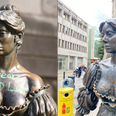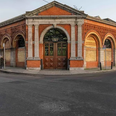I don’t believe gender imbalance is fundamentally ingrained in Irish theatre.
After all, our national
theatre was founded by a woman and a man (Lady Gregory and WB Yeats) in a
theatre building bought and managed by a woman (Annie Horniman). Women artists,
members of the Abbey company, were actively involved in both the 1916 Rising
itself and the debates around the founding of the Republic.
But the regression of women’s rights led by De
Valera and the 1937 Constitution is very much reflected in the Irish theatrical
canon. Since the opening of the new Abbey theatre building in 1966, just four
women have written for the main stage – Edna O’Brien, Jeanne Binnie,
Elaine Murphy and Marina Carr.
“The job of a national theatre is to stage the stories of the whole nation but the Abbey, in its 2016 programme, has become complicit in this erasure of women from our national narrative.”
Just as female activists of the Rising are not household names like their male co-patriots, so are female playwrights marginalised and forgotten.
The job of a national theatre is to stage the stories of the whole nation but the Abbey, in its 2016 programme, has become complicit in the historical erasure of women from our national narrative.

Actor Amy Ryan has voiced her support for the campaign
When the ‘Waking the Nation’ programme was announced earlier this month, it credited 18 men and just two women in the line-up of writers and directors.
That was when my colleague, set designer and project manager, Lian Bell started tweeting – and it wasn’t long before the #WakingTheFeminists hashtag was trending. The conversations which had long happened in private were suddenly made public.
It’s not a question of merit – and don’t let anybody tell you that it is
The thing about this is that there are so many brilliant Irish women writers working today – both in independent companies across Ireland, and those who have left to have their work produced by big houses in the UK and New York.
For instance, there’s Genevieve Hulme Beaman, Lucy Caldwell, Amy Conroy, Anne Devlin, Grace Dyas, Stacey Gregg, Nancy Harris, Deirdre Kinehan, Belinda McKeona and Carmel Winters. And that’s just scratching the surface.
“There is the brilliant example of New York-based writer Catherine Nichols, who sent her new novel to literary agents under a man’s name, George. There were 17 manuscript requests for George and two for Catherine.”
Women playwrights in Ireland
conventionally take one of two routes to get their work staged – they
bring it to the Royal Court or the Bush in London, or they start their own
independent company and direct it themselves.
When Abbey director Fiach Mac Conghail announced that
“all [his] new play choices are based on the quality of the play”, the implication
was that the women playwrights’ work not included wasn’t up to par.
But, the
reality is, if you don’t make an effort to establish long-term, working
relationships with enough women playwrights, then you don’t have the option to
programme brilliant new work by women playwrights.
Not malicious – but unconscious
Fiach Mac Conghail has since acknowledged that being called out on the programming choices has “made him question [his] own filters and the factors that influence [his] decisions”.
So what we’re really talking about is a gender bias. Its not malicious; it’s unconscious. And both men and women suffer from it. Much like when we live in straight society, we internalise homophobia – when we live in a patriarchal society, we internalise misogyny.

Promotional artwork for the 2016 programme. Photo: Abbey Theatre
Women’s work is often unconsciously considered messy, risky, unimportant, irrelevant. And this gender bias exists across all cultural contexts. There is the brilliant example of New York-based writer Catherine Nichols, who sent her new novel to literary agents under a man’s name, George.
There were 17 manuscript requests for George and two for Catherine.
So with that sort of unconscious sexist lens on, how could you say that the best material is what gets selected?
And there’s a reason why The Abbey is the right place to make this point
The Playboy Riots at the Abbey Theatre in 1907 were arguably the first time that Irish society started to have a conversation with itself. Since then the Abbey has unquestionably been a site for political statement and cultural change.
As I said, many of the original Abbey company were involved in the formation of the Free State. And of course, in 2014 the significance of Panti speaking those words that made the rest of Ireland start listening to the marriage equality campaign, was underpinned by the fact that they were spoken from the stage of our national theatre.
Not only is this centenary programme
a missed opportunity to address the revision of Irish history, particularly
around 1916, which has erased women’s voices – but it was also a missed opportunity to
engage with the diversity of voices that reflect Ireland in 2016, queer voices,
ethnically diverse voices, voices of different classes, ages, bodies, and
abilities.
So what are we fighting for, exactly?
What #WakingTheFeminists has called for is for the Board of the Abbey Theatre to lead the way in establishing equality for women artists.
We believe the key objectives of this are sustained policy for inclusion with an action plan and measurable results; championing and equal advancement of women artists and economic parity for all working in the theatre. Gender inequality exists across all sectors of Irish society, and this is an opportunity for us to talk about that in the very public sphere that is the arts.

Actor Debra Messing showed her support for the campaign
Everyone will have their different take on it but for many of us whose livelihood is making theatre, art and politics are intrinsically linked. That’s why this campaign is so galvanising; it’s a conversation led by those working in theatre about the reality of inequality in our working lives.
And that, we feel, is something with which people from all walks of life will be able to identify.
Topics:
RELATED ARTICLES






MORE FROM Lovin Dublin
























MORE FROM Lovin Dublin




















